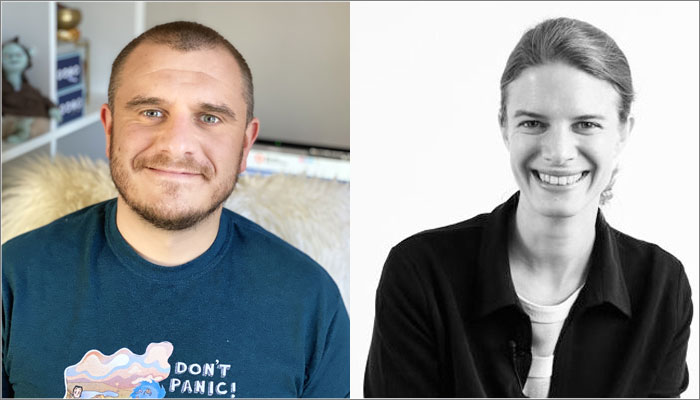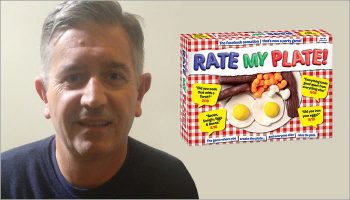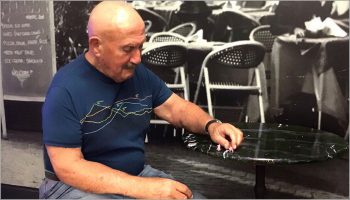Phil Tottman and Yesim Kunter on playful learning, mental health and the growth of Book of Beasties

Book of Beasties is an award-winning mental wellness card game, which aims to raise emotional literacy, teach resilience and empathy and encourage open conversations about mental health and wellness.
With expansions on the way and a collaboration with play expert Yesim Kunter in full swing, we caught up with both Phil Tottman, CEO and founder of Book of Beasties, and Yesim, to find out more about the company’s approach to game design.

Phil! Great to reconnect; we actually used to work at the same publishing house, you on Mobile Entertainment and me on ToyNews. So was the seed of Book of Beasties bubbling away back then?
PT: It was actually around that time that I was struggling with own mental health. In 2013, when I started at Intent Media, I was doing lots of different things at the same time and it became a bit much. I had a form of breakdown, and that led to me making some questionable choices and life decisions and I ended up being homeless. I used to sleep in my car opposite the office.
After I left that job, I went to another journalism job in London and stayed there for a short while, but I wasn’t feeling great. So I left and revaluated my life; I wanted to look at why I’d got to where I was, why I made certain decisions and how I didn’t see this thing coming. I realised I hadn’t been managing my emotions properly.
Myself and a friend – Tom Dryland – who then became my co-founder, along with my wife – Nadia De Kuyper – who is my other co-founder, had experiences of mental ill health and were looking at where we could make an impact. I hadn’t been introduced to the idea of wellbeing, or even to my own emotions, as a child and I didn’t have that knowledge as an adult; that possibly led to my issues happening.
We had lots of friends who were teachers and we asked them what kinds of provisions they had on mental health, and there was very little; this was three or four years ago. There wasn’t much there that was evidence-based, or child-led, and it just wasn’t playful. Instead, it was designed for teachers to deliver to children, to get children to talk about their emotions. Thick books, black and white pages; it wouldn’t inspire me to talk about my feelings, let alone a child!
And Book of Beasties came from this need to talk about these issues in a more engaging way?
PT: Absolutely. We thought we could create a physical game. At that time, Fortnite was blowing up, so we wanted to do something that didn’t involve a screen and instead do a physical card game that could bring children into the moment. We wanted it to be narrative-driven, playful and something that would immerse them in the world of mental health and address these topics in a way that feels more comfortable.
We didn’t know much about play back then, but one of the first things we wanted to do was to get psychologist involvement and endorsement. It turns out there was a world of research into the benefits of play. That was awesome and confirmed we were on the right path.

To back-pedal a little, we should delve into game itself. For anyone that hasn’t played it yet, what’s the game about?
PT: The idea of Book of Beasties is to help as many beasties as possible, and each beastie represents a manifestation of anxiety or depression or a collection of emotions that fall into that spectrum.
You help the beasties by using special items and each item translates into a wellness exercise or a topic of discussion. We themed the games around sessions; there are ten different types of beasties and three different versions of each type, so there are loads of activities and opportunities for discussions.
The game itself is around matching symbols, so it’s simple and aimed at kids aged six to 12.
Brill – and what were those first steps of development like? I imagine it’s the sort of game that goes through a lot of playtesting to check it’s helping children open up?
PT: Yes, we developed the game and started trialling it with children, under the supervision of teachers and psychologists. It worked better than we ever thought. It had the children opening up, willing to address topics that they hadn’t spoken about before and the game was even getting them engaged with things like yoga. We aspired to raise emotional literacy and encourage conversation around mental health, and it was doing that.
How did you get the balance right between achieving those aims, while also creating a game that’s engaging and genuinely fun to play?
PT: As soon as someone says to you “how do you feel?”, you immediately put up barriers, even if you don’t mean to. If that’s how you start a conversation with a child, it’s not going to work. That’s why we prioritised the game side of it. We looked at what we would be willing to interact with as a child and prioritised the game and the fun stuff. We introduced activities that we thought would make for an enjoyable experience for a child.
For example, we introduced deep breathing into the game. It’s a common wellbeing tactic that adults use, but children aren’t so keen on it because it’s boring! So, in the game, we have paper boat races that sees children use deep breaths to blow a boat across a table.
When we were trialling the game, we asked the kids if they liked it, and they told us to change this, change that; pretty much all the rules were changed by the kids. The rules in the game now are not our rules, they’re the kids’ rules! They pretty much designed it!
At the time, we thought if it’s fun to do, then a child will remember it, but we soon got to a point where we really needed psychologist input. But the fun element came first.
And delving into that psychologist side of things, who did you turn to?
PT: We partnered up with two psychologists from a charity called Action for Happiness, and then we partnered with the University of West London. They came in and started doing rigorous testing and a pilot study, which was super successful.
Where does Book of Beasties sit? Do you see it in the games aisle or strictly in schools?
PT: It was – and still is – a school resource aimed at Special Education Needs (SEN) Co-ordinators within schools, but we have seen a small uptake of our resources being used in the home environment.
You can’t help but get lost in the world of the game and so I think we will see an increase in the game being played within both the home and the school market.
Recently we found out that the game was also being used at Great Ormond Street Hospital by patients who were isolated. It went down really well and the kids loved it, so off the back of that, we’ve officially partnered with Great Ormond Street Hospital. There’s also a social care organisation called Change Grow Live; they use the game too. So it can be slotted into lots of different scenarios.

And Yesim, let’s bring you in now; how did you come across Book of Beasties?
YK: It was an unlucky situation that turned into a lucky one! During lockdown, the Kew Gardens area created a Facebook group. Phil posted about Book of Beasties on there, I saw it and thought it was amazing and wanted to be a part of it.
I’ve always been interested in mental health, but also in genuinely understanding children, how they play and how they understand themselves. And also how all that translates into learning.
Looking at the wider toy and game space, are we getting closer to these sorts of products becoming mass market?
YK: Mass market companies have always tried to put some kind of emotions into their products, because it’s so important for kids. But it’s very hard to properly translate those kinds of ideas into a toy, especially for a global market. It needs to come from a place of understanding the age group and how they relate to each other and themselves. Truly defining what the end result is and what your aims are with these kinds of products is where it becomes difficult to budget for it within some bigger companies.
But, within the last five years, with creative toys becoming really popular, emotions have become super important again, and with Covid, you can’t escape discussions around this and mental health. It really is the most important subject now.
Mattel recently did a study into empathy and doll play with Cardiff University and it’s amazing how by adding research into the mix it helps people recognise that play is important.
Are parents pushing this too? I imagine younger families are more open when it comes to discussions around mental health than previous generations.
YK: Yes, you’re right. Covid just accelerated this; it has been boiling up anyway. Most of us are more connected to our own selves, and interested in understanding who we really are. 15 years ago, you might not be asking those questions of yourself but now, everybody is asking those questions. It has become a natural way of connecting with your child, so of course those questions will be asked.
Colouring books for adults has been a big thing for about six years now. It didn’t come out of nowhere; people were realising they needed some kind of creative outlet. There’s so much stress going on that people need these kinds of bubbles to keep yourself sane, happy and connected.
PT: Mental health used to be a taboo subject. Before, you’d think it was a bad thing, whereas now we see it as something that everyone has and everyone has to maintain, like your physical health. Parents are now willing to accept this and know that playing a metal wellness game with their child, it doesn’t mean their child is unwell or broken, it means they’re learning.
Schools are also becoming more open to the use of play. In the UK, the traditional method of education is memory-based. You teach children how to remember things, and then they’re tested on it, and that’s how we determine intelligence. I feel like that will go out of fashion as time goes on because playful methods of learning are far more effective and people are starting to realise that now.
Is it a cultural thing? If we look over at our Scandinavian friends, it seems playful learning has been embraced and is working well…
YK: Yes, Scandinavia is doing really well with this; they totally understand that free play is important. Recess time is shrinking across the whole world – aside from Scandinavia – and that’s sad. We’re right to be envious of them! I would be, especially coming from a country that’s all about memorisation learning. I think memorisation is a great skill to have, but it doesn’t mean that you know how to learn. Playful learning is the only way to go.
Great design, impressive hair and now playful learning; I’ve got lots to be envious of when it comes to Scandinavians! And Phil, looking ahead, what’s the future got in-store for Book of Beasties?
PT: We’ve been in talks with Asmodee recently, looking at potentially reaching out to retailers. I certainly see opportunities in the more commercial market.
Yesim and I are also working together on a project for younger years. We’re working with the University of Surrey on a board game for younger years that promotes healthy sleeping habits, mindfulness and wellness. There’s nothing out there like it, and it’s shaping up to be amazing. And that’s aimed at the home, so it’s a more commercial prospect.

And will you return to the world of Book of Beasties? I imagine there’s enough in there in terms of characters and locations to turn it into a fully-fledged brand across multiple categories outside of games.
PT: 100%. Everything we create follows a narratives and we’ve got comics on our site that takes children fully into our immersive world. We are at the beginning of growing this massive universe. Pokémon has created an incredible world and that’s what we’re aspiring towards with Beasties. We have 10 expansions to the game planned, and we plan to release one a year from next year onwards. It’s going to grow and grow and grow.
Before I let you go, the game has been around for a few years now, so you have met people that have engaged with Beasties and had real effective change happen as a result?
PT: The teachers that use it are incredible, wonderful people. They took a chance on us and on a new type of learning and they were open-minded.
The pilot study saw a small group of children use the game and we interviewed the kids and their parents before and after. The parents of one of the boys in the group told us they hoped the game would increase their son’s emotional intelligence and understanding of others, but they said they were not prepared for such a dramatic transformation in their son. That was incredible to hear, especially coming from a parent.
Another example was a child who had severe behavioural issues where he refused to learn and wouldn’t interact with his teachers or his fellow students. He would get fed up and leave the class. They asked if we could go in and introduce the game to him. We sat down with him and had him talking to us about the game for around an hour. He spoke about the characters and rocket ships and then started opening up to us. He told us that he doesn’t speak to his classmates because he thought they didn’t like him. He said he felt lonely and felt judged by his teachers.
His learning mentor had never seen him open up like that; he even did yoga with us! Since then, he’s used the game as part of his daily routine, and that’s really heart-warming.
Great stuff; and before I let you go, could you talk us through your new Playful Minds initiative? It sounds brill.
PT: Yes, Playful Minds is our campaign that Yesim is the ambassador of. We’re calling on the government to increase funding for mental health provisions in schools, with a focus on playful mental health provisions.
We’re on Twitter @PlayfulMinds or go to https://www.bookofbeasties.com/playful-minds to sign up and get our manifesto.
Brill; thanks again Phil and Yesim. And good luck with the new campaigns and products.
PT: Thank you! And one more thing, we are actually looking for a publisher for the game at the moment, so if anyone wanted to reach out to have a chat, we’re at [email protected].
Perfect! Let’s hope you get some interest. Speak soon.
—-
To stay in the loop with the latest news, interviews and features from the world of toy and game design, sign up to our weekly newsletter here

























